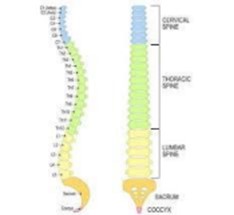When classifying spinal cord injuries, which of the following does the nurse understand is an example of the level of injury?
Quadriplegia
Incomplete loss of function
CA injury
Hyperextension
The Correct Answer is C
Choice A Rationale: Quadriplegia is a type of paralysis that affects all four limbs and the trunk, usually caused by an injury to the cervical spine (C1-C8).
Choice B Rationale: Incomplete loss of function refers to the extent of injury and whether some neurological function remains, not the level of injury.
Choice C Rationale: CA injury refers to cervical spine injury, which is the most common level of spinal cord injury.
Choice D Rationale: Hyperextension, like other mechanisms of injury (such as compression, flexion, or flexion-rotation), can contribute to spinal cord injury but does not define the level of injury.

Nursing Test Bank
Naxlex Comprehensive Predictor Exams
Related Questions
Correct Answer is B
Explanation
Choice A Rationale: Sedatives may not be the first choice for managing behavioral issues in clients with Alzheimer's disease, as they can increase confusion and fall risk.
Choice B Rationale: Antipsychotics may be considered in cases where behavioral issues pose a safety concern. They can help manage agitation, aggression, and other challenging behaviors.
Choice C Rationale: Cholinesterase inhibitors are used to treat cognitive symptoms of Alzheimer's disease but may not directly address behavioral issues.
Choice D Rationale: Serotonin reuptake inhibitors are typically used to manage mood disorders and may not be the first-line choice for behavioral issues in Alzheimer's disease.
Correct Answer is A
Explanation
Choice A Rationale: some medications that are used to calm down people with dementia can have serious side effects, especially for older adults. One of these side effects is an increased risk of experiencing a stroke, which can be life-threatening.
Choice B Rationale: Increased blood pressure can be a side effect of some medications used to calm patients with dementia, but it may not be the primary reason for not prescribing such medications. Furthermore, some medications can lower blood pressure, not increase it.
Choice C Rationale: Increased risk for infection is not typically a reason to avoid medications to calm dementia patients.
Choice D Rationale: is partially true because some medications can increase the risk for falls, but this is not the main reason why they are avoided.
Whether you are a student looking to ace your exams or a practicing nurse seeking to enhance your expertise , our nursing education contents will empower you with the confidence and competence to make a difference in the lives of patients and become a respected leader in the healthcare field.
Visit Naxlex, invest in your future and unlock endless possibilities with our unparalleled nursing education contents today
Report Wrong Answer on the Current Question
Do you disagree with the answer? If yes, what is your expected answer? Explain.
Kindly be descriptive with the issue you are facing.
